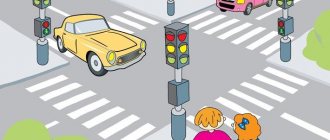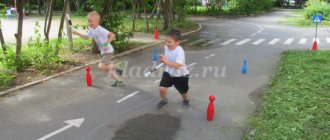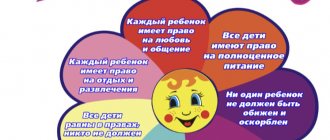Pictures of road signs
Clear drawings of signs with analogies will help you remember the most important symbols that you will encounter on your way to elementary school or kindergarten. Vivid images and simple explanations allow you to instantly attract attention and convey information quickly, cheerfully and clearly.
Thanks to road pictures, the child learns to be independent and make the right decisions. The main goal is to show that participation in traffic is not as scary as it may seem. If you understand the meaning of road signs, you can organize your own actions.
Road pictures are different for each age category. Children learn in the presence of an adult, who prompts actions and explains signs.
Didactic games on traffic rules in the preparatory group
Preschoolers in the preparatory group are preparing for school; they already know about the rules of behavior on the street and in transport, and understand road signs and markings. You just need to consolidate this knowledge. It is also important to pay attention to the speech and mental development of preschoolers.
Find the sign
Children are shown lotto pictures depicting different situations, but without road signs. The players’ task is to find a suitable one among the separately prepared signs and put it in the picture where it should be in reality.
I am a passenger
The teacher shows the students cards depicting different situations in public transport. Players take turns taking pictures, telling what they see: whether the characters are doing the right thing or not, if not, then they explain what they would do.
Name the signs
A couple is playing. Players take turns naming the road signs they know. The one who remembers the most wins.
Crossroads
The teacher introduces students to the types of intersections, shows the corresponding pictures, and tells them how to cross them correctly. Children should learn that intersections can be controlled or unregulated, and their configurations are cross-shaped, T-shaped, Y-shaped, or with a roundabout.
Pictures of traffic rules for children
This is a fun activity for different age groups, which at the same time brings great benefits. Every child, just starting to walk, becomes a participant in traffic - goes to kindergarten or school, walks in the yard, learns to ride a bicycle. Studying from strict books is boring and difficult, so as an alternative we offer bright drawings with clear messages.
The learning process attracts the child with its accessibility and diversity. Any adult can help understand the images by adding examples from personal experience to the drawing. As a result, confidence in himself and his actions in any situation is formed, he will not be confused or scared at the sight of a moving car and will know what to do at a pedestrian crossing. Traffic rules drawings are quick answers to children's questions.
Show your child educational videos and cartoons
There are many videos on YouTube in which children are told the rules of the road:
- "Lukomorye Pictures". Series “Traffic Light”, “Sign “Caution, Children!””, “Pedestrian Crossing”.
- "Lessons from Aunt Owl." Series “The Road” and “The ABCs of Road Safety.”
- "Robocar Poli. Traffic Laws".
- “Smeshariki. The ABC of Security." Episodes 1–7, 12, 14–16, 20, 24–32.
- Video lesson on the world around us “So that the path is happy.”
- Educational video “Road Rules (TRAF) for children: road safety.”
From videos and cartoons, the child will learn how to behave on and near the roadway, what rules should be used to cross the road, and what will happen if you do not follow the rules.
Road alphabet in pictures
This is play-style learning. Vivid images are better remembered and attract children's attention better than dry texts and abstruse phrases. This alphabet has a dual function - visual teaching of literacy plus familiarization with road traffic and its participants. The child will easily remember the order of letters in the alphabet and their spelling, and will also know the designations of markings, signs, vehicles, etc.
The participation of an adult in the process of learning the alphabet can only be limited to testing the acquired knowledge. Colorful pictures and simple explanations are learned by children of different ages. As a result, the child is well oriented in traffic situations, learns in which places to cross the road, and will be able to distinguish between traffic lights and road sign designations.
Consultation “When and how to start explaining traffic rules to children”
Yulia Yashkildina
Consultation “When and how to start explaining traffic rules to children”
When and how to start explaining traffic rules to children?
Sometimes the street is very dangerous
Both in the city and in the wilderness.
It's good to know the road rules
Everyone should kids.
Children can and should be taught such important rules from the age of one and a half years. Usually they begin to pay a lot of attention to this when the baby can move independently. Of course, at this age, the child will not yet be able to remember where to look when crossing the street and what light to stop at. This does not mean that there is no need to study.
Teach your children about traffic rules based on the following recommendations:
Together with your children, look at pictures of different types of transport, teach them to name them, show them, and recognize them on the street. It is important to know and distinguish the sounds of different vehicles and be able to pronounce them.
Books with stories and stories about the road, transport, as well as cartoons on these topics will be good teaching aids.
With 2-year-old children, you can already play simple games that simulate situations on the road. For example, children will be happy to remember the colors of a traffic light and what to do when a light is on. To do this, adults can show the child circles of red, yellow or green colors and combine them with movements (stand still, clap your hands or walk).
With a child over 3 years old, it will be useful to draw, for example, the road from home to a store or kindergarten, read and learn simple poems about traffic rules for children, solve riddles, look at road signs on the street and special toy road signs for children at home.
It is necessary to develop children's understanding of space and speed of movement. Exercises to determine the distance of an object will help with this. Select for the child any object or object in the field of view and ask him to describe in words far or close, in front or behind, to the right or to the left. Teach your child to determine whether he is walking fast or slow (a car is moving).
“WHAT YOUR CHILD SHOULD KNOW.”
In an environment of constantly increasing traffic intensity and an increase in the number of accidents, it is difficult for pedestrians to cope without knowledge of traffic rules. It is wiser to start studying traffic rules long before children go to school.
The child must know.
1. The way from home to kindergarten.
2. Know the following traffic rules: do not walk on the pavement, cross the street in indicated places, walk calmly without jostling, speak quietly, etc.
3. Know a number of road signs, their meaning and purpose (warning, prohibiting, indicating, traffic lights.
4. Know the rules of behavior in public places and transport: wait for the bus only at the bus stop, do not touch the doors while moving, do not lean out of the window, do not put your hands out the open window, do not stand with your feet on the seat, do not walk on the bus, do not cling to moving transport.
MEMO FOR PARENTS OF CHILDREN of senior preschool age
Dear parents!
In a timely manner, teach children the ability to navigate traffic situations, instill in the child the need to be disciplined and attentive on the street, cautious and circumspect.
Do we, adults, always set an example for our children to follow the rules of safe crossing of streets and intersections, and boarding a bus?
Remember! By breaking traffic rules, you are, as it were, tacitly allowing your children to break them!
Teach your child:
do not rush when crossing the street;
cross the road only when no one is blocking your view;
Before crossing, wait for the vehicle to leave the stop, then your view of the street will not be limited. Careless crossing of the street due to stopped vehicles often leads to accidents.
Teach your child the ability to be vigilant and attentive on the street. So, when you find yourself next to a standing bus, invite your child to stop and look carefully to see if a car is approaching.
Explain to him what danger a pedestrian can expect if he suddenly steps out from behind a stopped vehicle onto the roadway. A pedestrian does not see the moving vehicle, drivers do not see pedestrians.
Games will be of great help in consolidating your knowledge of road traffic. Make houses, sidewalks and pavements, pedestrians, and toy vehicles out of cubes and multi-colored paper. Using this layout, you and your child can role-play various road situations, thanks to which he will more firmly and meaningfully master the rules of behavior on the street.
To consolidate children's knowledge of traffic rules and traffic signals, use:
— board games: “We are driving along the street”, “Signs on the roads”, “Learn to drive”, “Young drivers”, “Your friends”, “Talking signs”, “Traffic lights”, “Three letters”, etc.;
- filmstrips: “On the inadmissibility of pranks on the street”, “On possible and impossible events”, “Don’t play on the pavement”, “Road primer”, “Once upon a time in the city”, “Alesha’s bicycle”, “Santa Claus is a traffic controller” ”, “The Adventures of Ilya Muromets in Moscow”, “Uncle Styopa is a policeman”, “The Adventures of Tima”, etc.;
- children's works of art followed by a conversation about what they read: “A Bad Story”, “Uncle Styopa the Policeman” by S. Mikhalkov; “A car on our street” by M. Ilyin and Segal; “Meet the car”, “Laws of the street and roads”, “Road certificate” by I. Serebryakov; “Look, guard”, “This is my street” by Ya. Pishumov; “Red, yellow, green” by A. Dorokhov and others;
-albums for coloring: “Road Letter”, “Food, Food, Food”, introducing road signs and their meaning.
Use walks with children to explain to them the rules of safety on the streets:
-observe the operation of the traffic light, draw the child’s attention to the connection between the colors at the traffic light and the movement of cars and pedestrians;
show your child signs and traffic indicators, tell them about their meaning;
- invite your child to find his own way home when you take him with you, going to the store, for a walk, etc.;
often turn to your child while driving down the street with questions about what, in his opinion, should be done on the street in this or that case, what this or that sign means;
-explain to your children your behavior on the street: the reason for stopping on the sidewalk to survey the road, choosing a place to cross the road, your actions in different situations.
Don’t waste time on “lessons” on how children behave on the street.
If you bought a bicycle for your child, then you need to explain to him the rules for using it on the street, demanding strict compliance.
The child must learn: you can ride a bicycle only in designated areas - courtyards, parks, squares. Tell your children about the mistakes cyclists make that lead to accidents.
Please remember that children under 14 years of age are prohibited from riding bicycles on the roads. You should not place your child on the frame or rack while riding your bike. For a child, a special saddle and footpegs must be made on the bicycle frame behind the handlebars.
By the time a child enters school, he must have learned and observed the following rules of conduct on the street and in transport:
play only away from the road;
cross the street where there are crossing signs; where there are none - at intersections along the sidewalk line;
cross the street only at a walk, do not run;
watch the traffic light when crossing the street;
When crossing the street, look first to the left, then to the right;
do not cross the path of approaching traffic;
Always walk around cars parked on the road near the sidewalk or shoulder so that you have a good view of the road and carriageway; Always go around the front of the tram;
enter any type of transport and exit it only when it is stationary; you cannot jump while moving;
do not lean out of the window of a moving vehicle;
get out of the car only on the right side when it has approached the sidewalk or side of the road;
do not ride your bicycle onto the roadway;
If you are lost on the street, don’t cry, ask a passing adult or police officer to help you, give your address.
The goal of my work is to develop safe behavior in preschool children through familiarization with the rules of the road.
When starting to teach children traffic rules, I set the following tasks:
1. Expand children’s understanding of the surrounding road environment and road rules.
2. Introduce children to the meaning of road signs, teach them to understand their schematic representation for correct orientation on the streets and roads.
3. Develop the ability to practically apply acquired knowledge in the road transport environment.
4. To cultivate discipline and conscious compliance with traffic rules, a culture of behavior in the road transport process.
5. Intensify efforts to promote traffic rules and a safe lifestyle among parents.
Girls and boys,
All, without exception,
Learn the rules
Traffic!
Non-existent road signs
This is a great conceptual way to develop a child's understanding of the world. Based on simple drawings, the child develops logical thinking, associative perception, and adapts to social life. Road traffic is an integral part of modernity, vehicles and pedestrians intersect everywhere. Understanding the basics of traffic rules means being safe.
Pictures with non-existent road signs are beneficial because they develop in the child an idea of real symbols that need to be followed. At the same time, fantasy develops thanks to imaginary objects. Children easily reproduce or invent new colorful images. This learning process is built in a game format and is preparatory to further study of the signs from the Rules.
Didactic games on traffic rules in the younger group
Kids should understand the names and purposes of vehicles, traffic lights, and main road signs.
Find the extra word
The teacher names 4 words, and the children must say which one is superfluous in meaning. Examples:
- tram, barn, tractor, ambulance;
- swing, excavator, trolleybus, truck;
- boat, boat, bus, yacht;
- scooter, roller skates, bicycle, car.
Traffic light repair
To play, you need a contour image of a traffic light and 3 circles corresponding in size to its “eyes”: red, yellow, green. The teacher explains to the students that the broken device needs to be repaired. Children place circles on the traffic lights in the correct sequence and tell what each color signals.
Collect the sign
To play the game, you need to print and cut into several parts images of road signs familiar to preschoolers of the younger group. It is also necessary to make copies of the pictures that players will use as a guide when folding the cut images. If a child quickly puts together pictures, you can ask him to complete the task without a sample.
Stop or go
For the game, the teacher prepares 2 signal cards - red and green. Hands out steering wheels made of cardboard to children. The teacher explains that when he shows the green card, the players should move as if driving a car. When the green card turns red, you need to brake.
We run across the road
The presenter has 3 cards corresponding to traffic lights. When the green one is raised, children run around the playroom, when the yellow one is shown, they jump or dance in place, and when the red one is shown, they stand still. Those who make mistakes are eliminated. The last player remaining wins.
Garage
Hula hoops are placed in the corner of the playground - these will be cars parked in the garage. There should be 4-8 fewer of them than players. The teacher turns on the music, the children dance. When the music stops, the players rush to the “garage” and hula hoop one at a time. Those who do not have time are eliminated.
Learn poems about traffic rules with your child, make riddles
Just learning and understanding traffic rules can be difficult. And in the form of poetry, it is easier for a child to remember the rules.
Using this poem, the child will remember when it is possible to walk across the road and when not. Source
Riddles will help you remember the concepts used in traffic rules: roadway, sidewalk, underpass, traffic light, railway crossing.
It is more fun and interesting for a child to solve riddles than to answer ordinary questions about traffic rules. Source




